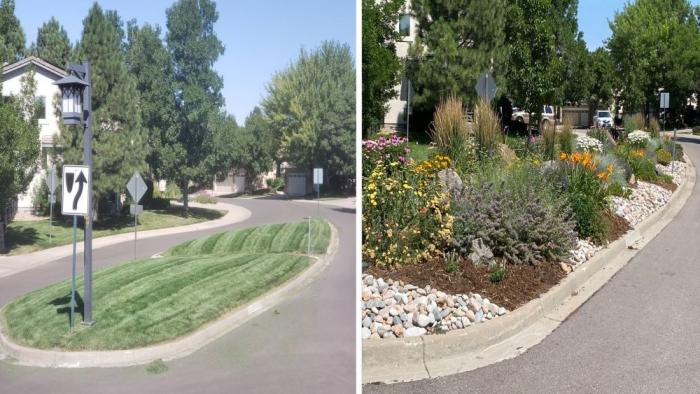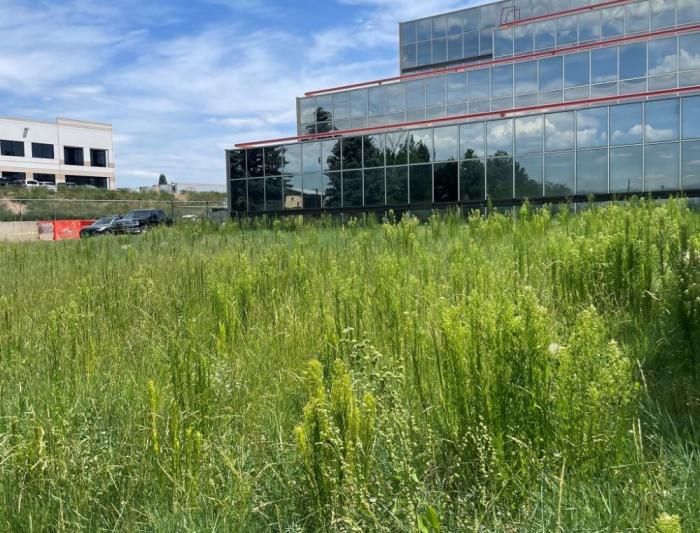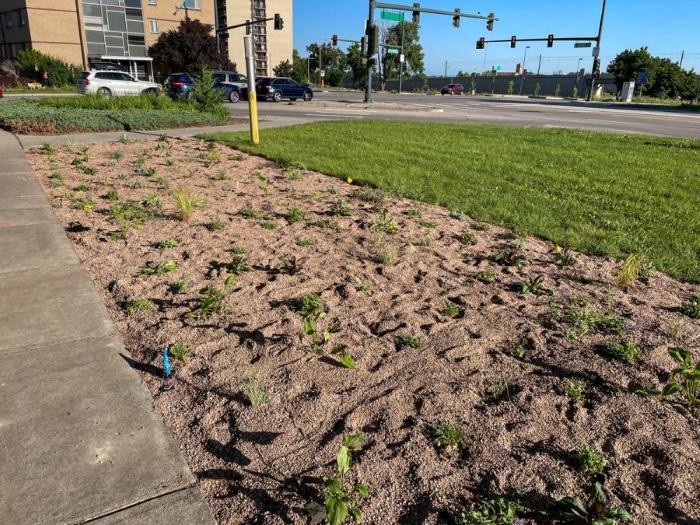Don’t put grass where it doesn’t work
Drive down just about any road in Denver and you’re likely to see a strip of decorative green Kentucky bluegrass turf growing beside the road, in the median or crammed between the road and a sidewalk.
You wouldn’t throw a picnic on it. Or venture onto it to toss a ball to a friend or family member. It’s grass that’s only visited when it’s mowed.
It’s called nonfunctional decorative turf, it needs a lot of extra water to survive in our semi-arid climate, and there are better choices for plants that provide a more natural fit for our communities.
“There are places where grass is useful, where it serves a community or recreational purpose, like on parks and playgrounds, sports fields and picnic areas,” said Andrew Hill, a government affairs manager for Denver Water.
“With this proposal, we’re shifting the thinking about where water-thirsty grass serves a purpose, like public parks, and where it doesn’t, like the middle of the street. While the status quo has long been to simply plant bluegrass everywhere, we know there are better, more water-wise plants that can thrive in our climate, are beautiful, and provide a larger benefit to our communities,” Hill said.
Learn more about ColoradoScaping at denverwater.org/Conserve.
A proposed law, SB24-005, that’s been approved by the Colorado legislature and is awaiting the governor’s signature, would halt the expansion of nonfunctional, water-thirsty grass by prohibiting the planting or installation of high-water-using turf in commercial, institutional, or industrial property or a transportation corridor. The bill would take effect Jan. 1, 2026. It also bans artificial turf in these areas, but doesn’t require ripping out existing turf. It also doesn’t affect residential properties.
The proposed law has bipartisan support. The bill’s primary Senate sponsors are Sen. Dylan Roberts, D-Eagle, and Sen. Cleave Simpson, R-Alamosa. Primary House sponsors are Rep. Karen McCormick, D-Boulder, and Rep. Barbara McLachlan, D-Archuleta.
The proposal builds on efforts to transition Denver-area landscapes away from bland expanses of water-thirsty turf to more diverse, water-wise ColoradoScapes. These landscapes offer year-round interest using water-wise plants, prairie grasses and cooling shade trees that offer rich habitats for birds, pollinators and wildlife that live in the metro area.
“In the last 10 years, average temperatures in Denver have been 1.9 degrees Fahrenheit warmer than the 20th-century average,” said Greg Fisher, manager of demand planning for Denver Water.
“That means our community’s landscapes, including a healthy urban tree canopy that provides cooling shade, need to adapt to warmer temperatures while also conserving our precious water resources,” he said.
That work has already begun.
In 2023, the Denver Parks and Recreation department took aim at 10 acres of thirsty Kentucky bluegrass covering four medians separating the north and southbound lanes of Quebec Street, just south of Interstate 70 between Smith Road and Martin Luther King Jr. Boulevard. Over the summer, the grass was allowed to die for lack of water. Then in September 2023, the department had landscape crews from Western States Reclamation plant more than 60 species of prairie grasses and wildflower seeds through the remains of the dead bluegrass.
On the south side of the metro area, 3 acres of decorative, unused Kentucky bluegrass at the front of Arapahoe County’s Administration Building in Littleton is being transformed into a rolling prairie meadow. Work on that project began in 2022.
Denver Water also is transforming its own properties, including the ColoradoScaping of 12,000 square feet of what used to be water-thirsty turf at its Einfeldt pump station at the corner of South Buchtel Boulevard and South University Boulevard. The new landscape, planted in 2023, includes a native grass mix of buffalo grass, blue grama and inland salt grass, plus additional water-wise and native perennials.
Those projects are part of a larger statewide and regionwide push to create landscapes that offer a better fit for the climate and communities.
A 2022 Colorado law created a state program that offered financial help to local governments, nonprofits and other entities to replace irrigated turf with more water-efficient landscaping.
Also in 2022, Denver Water and dozens of other water utilities across the West committed to substantially expanding existing efforts to conserve water in recognition of the drought in the Colorado River Basin. The utilities also pledged to reduce the amount of decorative, nonfunctional turf by 30% within their service areas.
For Denver Water, a 30% reduction translates into transforming about 75 million square feet of turf into new ColoradoScapes. In 2023, the water utility worked to remove about 750,000 square feet.
“At that rate, it will take 100 years to meet the goal,” Fisher estimated.
“And while we’re transforming what’s already here, we can’t afford to keep planting more nonfunctional turf that will soak up our precious water resources, struggle in our warming environment, and eventually be turned into a ColoradoScape years later,” he said.
“This bill stops that cycle. It’s the right thing to do.”
On the residential front, Denver Water in 2024 offered a limited number of discounts to residential customers who want to use Resource Central’s turf removal program to begin transforming their water-intensive bluegrass lawns into water-wise, diverse ColoradoScapes.
The utility also is offering a limited number of $25 discounts on Resource Central's popular water-wise Garden In A Box plant-by-number kits, which are sold in the spring and the fall.
(Editor’s note: The Garden In a Box spring sale started March 1 and will continue until all the garden kits are sold out. Denver Water's limited number of discounts for the spring sale were claimed quickly. A limited number of discounts also will be available for the fall Garden In A Box sale. Sign up for Resource Central’s Garden In A Box newsletter to stay up to date on their programs, including future sales.)




